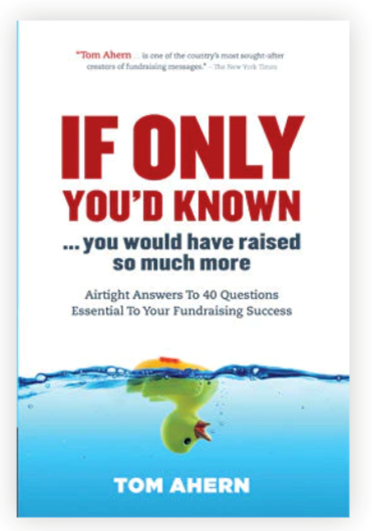The following is a hand-picked guest post from Tom Ahern. Enjoy, and you can read more about Tom below.
* * *
Do low grade scores read as dumbing down?
If you write an appeal at the 6th-grade level, you’re not targeting kids. You’re helping busy adults “get” your ask as fast as possible.
[The subhead above was written at the 6th-grade level, as scored by Flesch-Kincaid. It has a reading ease score of 76 out of 100, far ABOVE the desired minimum of 55. Did you recoil? Did you instantly think: “Dammit, Tom. Stop talking down to me!”]
——
There it was… in my email in-box: the Bat signal … from a friend and colleague…
Hi Tom,
I have a work problem and need your help, please!
When I got to [insert charity name here; it’s in NYC], they were passing the foundation’s quarterly impact reports verbatim on to major donors.
My boss saw that I have the comms knack and let me take over editing these to make them “individual-donor friendly” – mainly choosing one impact story and highlighting a person receiving benefit from our programs, with photo, etc…
Now we have a new VP of Development. The guy who writes these foundation reports directly reports to her… and she is now letting him stick his nose into what we are doing. He has no training in fundraising.
While I was at a doctor appointment a few weeks ago, my junior colleague agreed to share the draft he and I had been working on with this guy, who proceeded to torture him for 45 minutes and tell him how stupid he was for using low Flesch-Kincaid grade scores as our benchmark. To summarize the marcomm rant: “Our donors are not stupid” etc.
You’ve heard it all before.
So I have a very small window in which to educate this ignoramus. I have a big folder of stuff I’ve accumulated over the years plus books.
Do you have any sort of executive summary of Tom’s laws that I can share? If not, I can provide the kit and kaboodle to my colleague, and he can distill it down.
Best,
[name deleted]
PS: I can’t believe this is happening.
——
My reply to [name deleted]…
Preach, sister. (And so sorry!)
Clearly, your marcomm guy doesn’t know what he doesn’t yet know. And weren’t we all in those shoes once upon a time?
It’s almost an unbelievable story, after all.

Who would guess that the Flesch-Kincaid readability scales are one of the best-kept trade secrets of the world’s most successful direct-mail copywriters?
Or who would guess that these same Flesch-Kincaid ease-of-reading scales dictate how the U.S. Navy writes its maintenance manuals? Keeping that sophisticated machinery humming are bright, recent high-school graduates. Hey, sailor: Got a problem? Here’s how to fix it quickly. Even though you’re not a nuclear scientist.
So, my friend, here’s an excerpt from a book I compiled from experts around the world: If Only You’d Known….
If you’re looking for the equivalent to “Tom’s laws,” this is as close as I have.
Chapter 15
What’s the preferred “grade level” of reading for a direct mail appeal?
[ ] 6th grade
[ ] 9th grade
[ ] 12th grade
Grade level and speed reading
[Answer to the quiz above] You’re not sure, right? Well, what if I told you that this particular direct mail appeal hoped to raise donations from alumni of a prestigious university?
In that case, you might assume “12th grade.” The thinking: write at the same grade level as a person’s educational attainment.
Otherwise you commit the insult of “writing down.”
Not exactly
“Grade level,” as measured by the standard Flesch-Kincaid readability scoring system,[1] has nothing to do with your intelligence or how far you went in school.
The system scores just one thing:
How quickly my brain can move through your prose.
Below, on the left, are the readability scores for a successful direct mail letter.
On the right are the readability scores for a university-written case for support. The one on the left will be a brisk read for everyone. The one on the right will be a slog for everyone, including the Ph.Ds.

You decide.
Your writing can bring me clarity and quick understanding. Or your writing can bring me labor. Which do you think is more “reader convenient”… or appreciated?
[1] Built into Microsoft Word and available for free on the internet
* * *
Steven says, “Tom Ahern was described by the New York Times as “…one of the country’s most sought-after creators of fundraising messages.” Tom has what I’d call the industry-leading newsletter about fundraising. Being mentioned in it was a career highlight for me. You can (and should!) subscribe for free here.”








